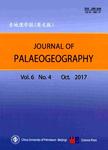The response of stromatolites to seismic shocks: Tomboliths from the Palaeoproterozoic Chaibasa Formation, E India
The response of stromatolites to seismic shocks:Tomboliths from the Palaeoproterozoic Chaibasa Formation,E India作者机构:Geocom Consultants Valle del Portet 17 03762 Benitachell Spain Department of Applied Geology Faculty of Science and Engineering Curtin University Sarawak CDT 250 98009 Miri Sarawak Malaysia Indian Institute of Science Education and Research Department of Earth and Environmental Sciences Bhopal By-pass Road Bhopal 462066 Madhya Pradesh India
出 版 物:《Journal of Palaeogeography》 (古地理学报(英文版))
年 卷 期:2016年第5卷第4期
页 面:381-390页
核心收录:
学科分类:070801[理学-固体地球物理学] 0709[理学-地质学] 070901[理学-矿物学、岩石学、矿床学] 07[理学] 0708[理学-地球物理学]
基 金:project was supported by the Foundation Dr Schurmannfonds,grants no.34/2006 and 57/2009,67/2010 and 82/2012 the DST and the Department of Geology,Calcutta University for financial support and infrastructural support
主 题:Stromatolites Seismic shocks Soft-sediment deformation structures Pataeoproterozoic Singhbhum craton Tombotiths India
摘 要:It is demonstrated here for the first time how Palaeoproterozoic stromatolites survived seismic disturbance of their substrate. The stromatolites under study could have been cyanobacteria or any other photo-autotrophic microbes, which formed mats that covered a substrate of very fine-grained sandstones and mudstones of the Chaibasa Fm. in eastern India. The sediments represent a shelf environment. The local abundance of the stromatotites suggests that the tow-energy environment formed a suitable habitat. The common phases of tectonic quiescence were, however, occasionally interrupted by seismic shocks. These were sufficiently strong to deform the mat layers, the tower parts of which might already have been (semi-) consolidated. The mats became partly folded, partly faulted, and already consolidated parts of the stromatotite layers broke off. This can be deduced from the angular shapes of part of the broken-off fragments. It appears, however, that part of these fragments were stilt sufficiently soft to become rounded and deformed by rotting over the seafloor, probably under the influence of tidal currents. When come to rest, these fragments served as a new substrate for new generations of the microorganisms. These micro-organisms thus survived by continued growth on the reworked fragments and built up new stromatolites that may show an ‘angular disconformity' with the stromatotites of their substrate. It thus is shown that stromatotites have an adequate response to a sudden disturbance of their habitat, and that they survive earthquakes by colonization of broken-off fragments. We call the ‘healed' fragments ‘tombotiths' (tumbled stones).



